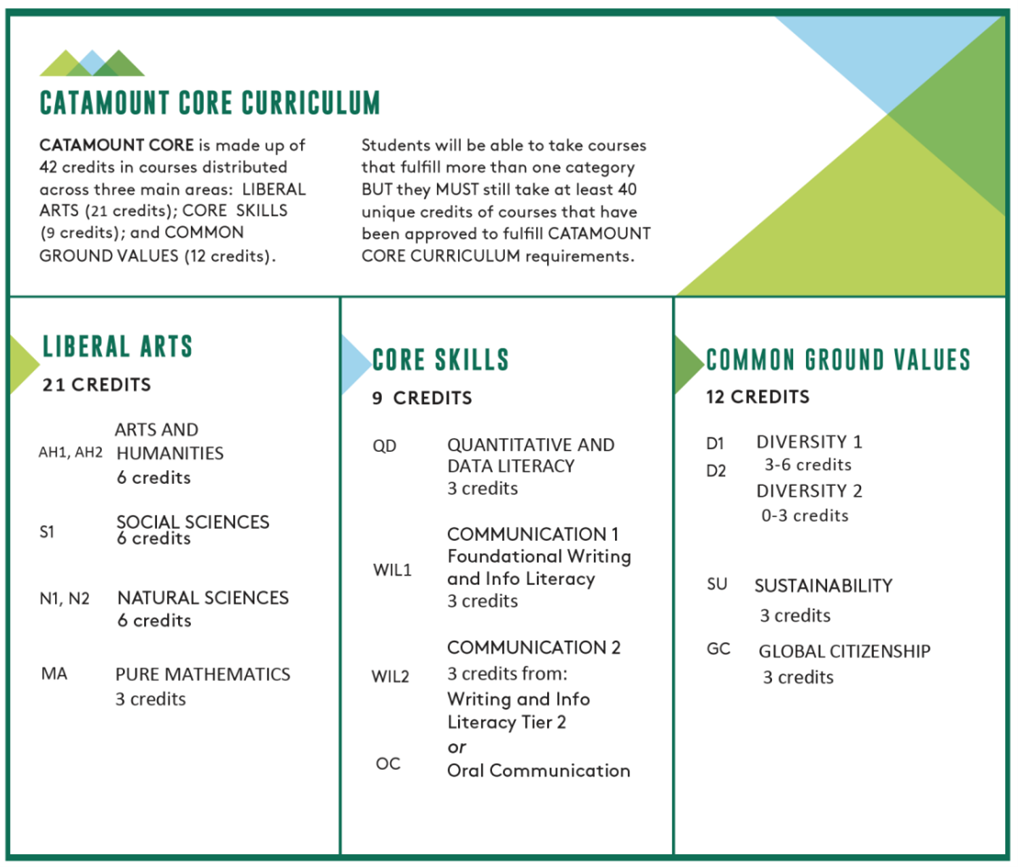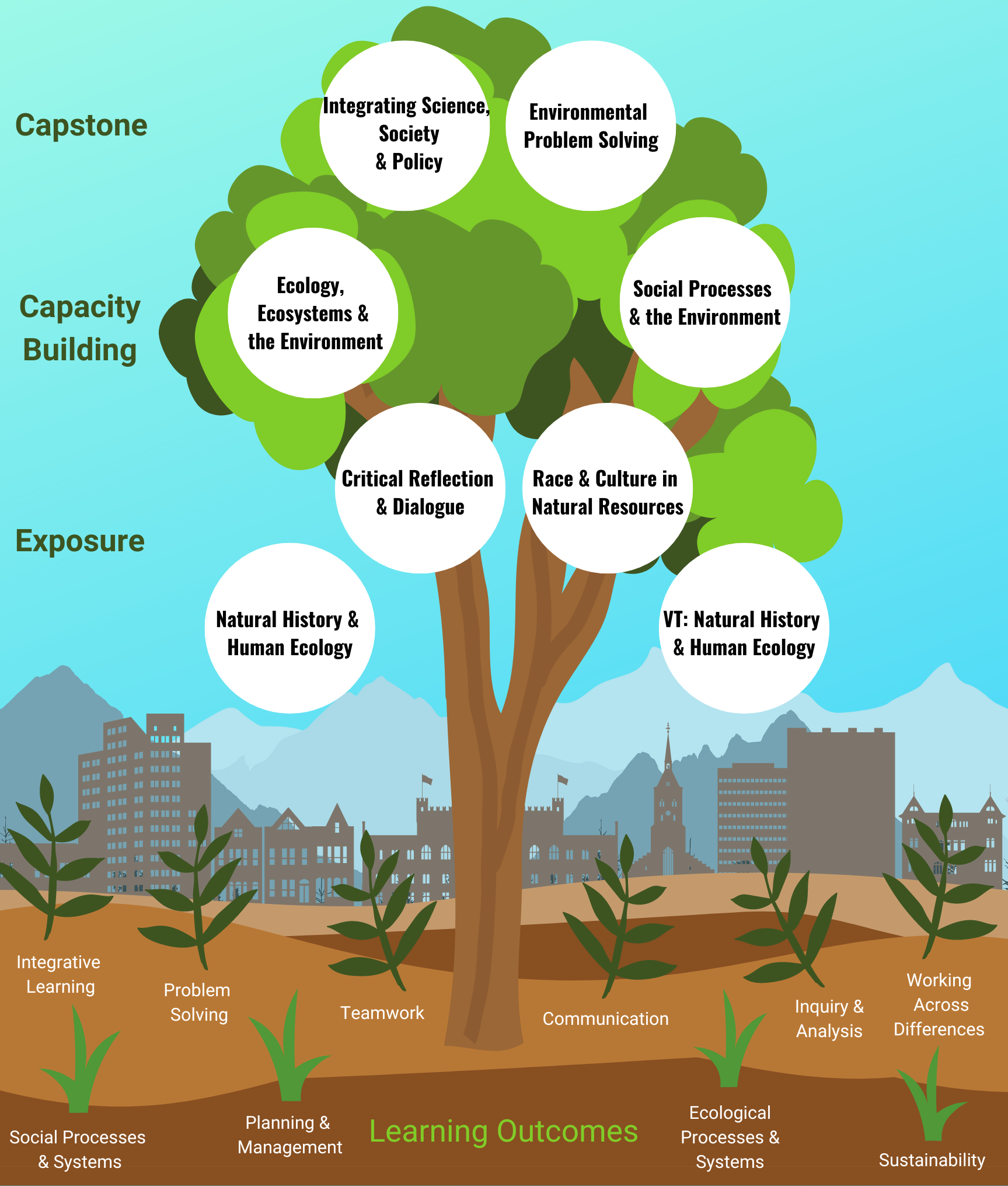Step 1: Understanding Your Degree Program
Review your academic requirements.
- Components of your degree include the Catamount Core Curriculum, which is designed to expose students to the intellectual breadth of the liberal arts, develop the skills needed to integrate and apply diverse areas of knowledge, and build the foundations for lifelong learning and active participation in local and global communities. The Catamount Core Curriculum is made up of 21 credits in Liberal Arts, 9 credits in Core Skills, and 12 credits in Common Ground Values, for a total of 42 credits. Many of these requirements will be fulfilled by the Rubenstein School Core Curriculum and program requirements for your major.

- The Rubenstein School Core Curriculum is designed to cultivate the skills and knowledge that we believe are central to the study of natural resources and the environment. The Rubenstein School Core Curriculum's eight required courses (25 total credits) are taken sequentially and cut across all academic programs within the School, integrating the natural and social sciences to foster a deeper understanding of complex environmental issues. As a first-year student in the Rubenstein School, you will be taking NR 1010: Natural History & Human Ecology and NR 1050: Critical Reflection & Dialogue in your first semester.

- The final component of your degree is the program requirements for your major. Explore the majors below to learn more about course requirements for each.
- Rubenstein students are able to pursue minors across UVM, although minors are not required for our programs. Explore minor and undergraduate certificate options.
Step 2: Course Registration
Review your schedule, search for interests, and watch the registration video.
- Please review your pre-registered schedule ahead of your course registration group advising meeting. Your schedule includes any classes required for your major, as well as additional degree-applicable courses appropriate for a first-year student. You will have the chance to add and/or change classes during your group advising meeting. To review your pre-registered schedule, login to your myUVM account and click the "My Schedule" tab. You will see a weekly overview of your schedule and can click on each course entry to see the course title.
- It is helpful to have identified some interests so you're ready if you need to add/swap any classes in your pre-registered schedule. Take a look through the Fall Schedule of Courses to explore by subject and/or search by General Education requirements in the interactive Schedule of Courses to find classes you are interested in.
- In order to make changes to your schedule (and register for classes in upcoming semesters), you’ll need to know how to use the UVM registration system. Watch the video below to familiarize yourself with the process. This process will also be reviewed in your advising meetings and in November ahead of Spring course registration.
- IMPORTANT NOTE: Please connect with a Rubenstein School advisor before making changes to your schedule. Feel free to reach out to our general email RSENRStudentServices@uvm.edu or to any of our advisors (Brittany, Cathy, Emily, or Jess) directly.
Step 3: Prepare for Your Group Advising Meeting
Download Teams, take placement tests, prepare questions.
- Download and set up Microsoft Teams, login using your UVM credentials, and test your account before your meeting. You can also access Teams meetings via web browser by visiting teams.microsoft.com and signing in with your UVM email/NetID and password. If possible, please join your advising meeting from a computer rather than a mobile device, as you will be asked to navigate webpages and resources.
- Take any relevant placement tests, such as the Foreign Language Placement (if you plan to take a language course) and the Math Placement Assessment (MPA) (needed for MATH 1212: Fundamentals of Calculus I and above). MATH 1212 is a required course for Environmental Sciences; Sustainability, Ecology & Policy: Applied Ecology; and Wildlife & Fisheries Biology majors. If you are an undeclared student considering any of these majors, it is highly recommended that you complete the MPA ahead of your advising meeting.
- We know this is all a lot to take in, so your advising meeting is also a time to ask questions! Take notes along the way and come prepared with questions.
Step 4: If You Haven't Already...
Download Navigate, review AP credit, check your email.
- Download the UVM Navigate App and explore the many helpful tools and functions, like how to schedule an appointment with your advisor!
- If you took any AP Exams, review the AP Comparability Guide to see how those credits may contribute toward your degree.
- Get into the habit of checking your UVM email regularly and often! This is how all UVM information will be disseminated moving forward.
- As you review your email, keep an eye out for fraudulant messages. Unfortunately you are likely to receive spam regularly and should always report it by forwarding the email to spam@uvm.edu. Students often receive spam advertisements for work opportunities, read up on how to identify fraudulent jobs and internships.

